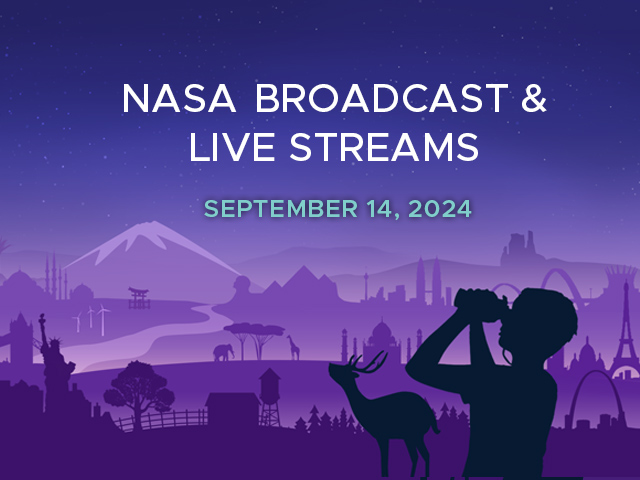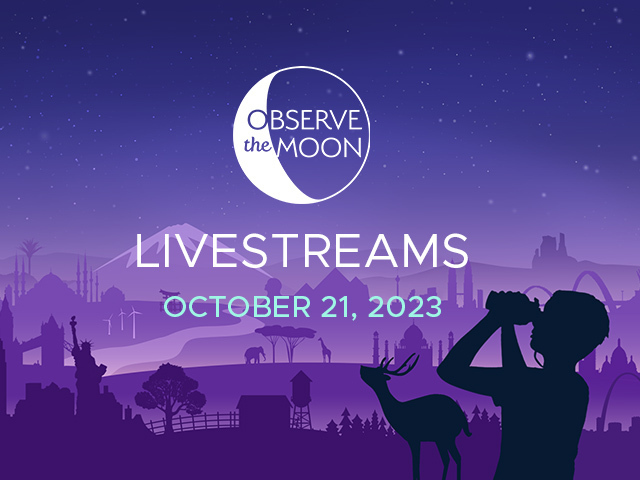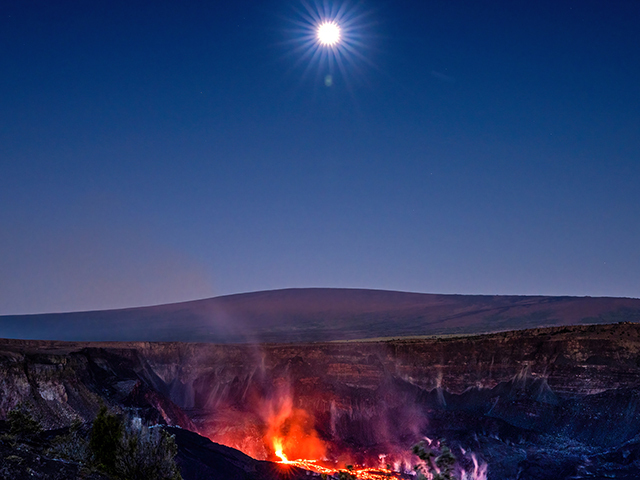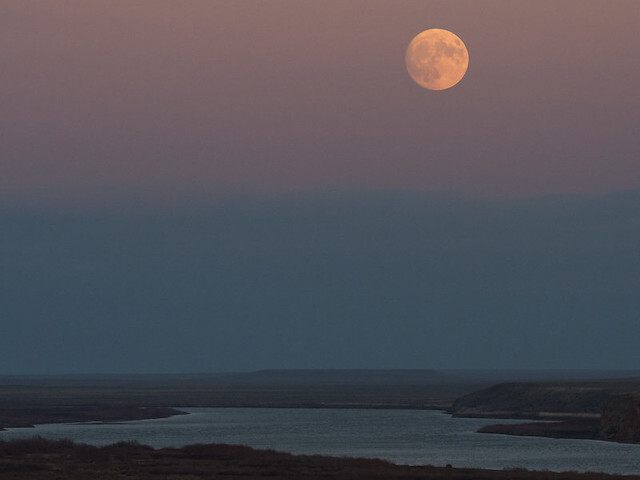News | November 1, 2017
Moon Missive: The Next Full Moon is the Hunter's Moon

Moonrise over the Syr Darya river, Sunday, Nov. 13, 2016, Baikonur, Kazakhstan. Credit: NASA/Bill Ingalls More ›
The next full Moon will be early Saturday morning, November 4, 2017, appearing "opposite" the Sun (in Earth-based longitude) at 1:23 AM EDT.
The Moon will appear full for about three days centered on this time, from Thursday evening through Sunday morning, making this a full Moon weekend.
This is the Hunter's Moon, the full Moon after the Harvest Moon. According to the Farmer's Almanac, with the leaves falling and the deer fattened, it is time to hunt. Since the harvesters have reaped the fields, hunters can easily see the animals that have come out to glean (and the foxes that have come out to prey on them). The earliest use of the term "Hunter's Moon" cited in the Oxford English Dictionary is from 1710.
The Maine Farmer's Almanac first published Indian names for the full Moons in the 1930's. According to this almanac, the Algonquin tribes of what is now the northern and eastern United States named the second full Moon of autumn the Beaver Moon. One interpretation is that mid-fall was the time to set beaver traps before the swamps freeze to ensure a supply of warm winter furs. Another interpretation suggests that the name Beaver Moon came from how active the beavers are in this season as they prepare for winter. Other names for this Moon are the Frost or Frosty Moon and the Snow Moon, although these names are also used for the last Moon of fall, usually in December.
In most lunar calendars the months change with the new Moon and the full Moons fall in the middle of the lunar month. This full Moon is the middle of Cheshvan in the Hebrew calendar, the ninth month of the Chinese calendar, and the month of Kartik in the Hindu calendar. Kartik Poornima, or the full Moon in the month of Kartik, is celebrated as a Hindu and Jain holy festival. Names include Tripuri Poornima or Tripurari Poornima, after Tripurari, teh foe of the demon Tripurasura. Another name is Dev Diwali or Dev Deepawali - the festival of lights of the gods. In the Islamic calendar the months start with the first viewing of the waxing crescent Moon, a few days after the New Moon. This full Moon is near the middle of Safar, the second month of the year.
As usual, the wearing of suitably celebratory celestial attire is encouraged in honor of the full Moon.
As for other celestial events between now and the full Moon after next:
In mid-autumn the daily periods of sunlight continue to shorten. For the Washington, DC area, at least, the mornings from Wednesday, October 25, to Saturday, November 4, 2017 (the day of the November full Moon), are the darkest mornings of the year with the latest sunrise times. Sunrise on the day of the November full Moon, Saturday, November 4, 2017, will be a full 12 minutes later (in Daylight Savings Time) than the latest winter sunrises in late December and early January (in Standard Time). On the day of the November full Moon, morning twilight will begin at 6:39 AM, sunrise will be at 7:39 AM, the Sun will reach a maximum altitude of 35.5 degrees at 12:51 PM, sunset will be at 6:04 PM, and evening twilight will end at 7:03 PM EDT. If you notice you have a lot of trouble waking up in the morning in late October and early November, this might be the reason (and even if it is not, it provides a plausible excuse for sleeping in...).
The next morning, Sunday, November 5, 2017, at 2 AM EDT, we "fall back" to 1 AM EST, making the change to Standard Time. Morning twilight will begin at 5:40 AM, sunrise will be at 6:40 AM, the Sun will reach a maximum altitude of 35.2 degrees at 11:51 AM, sunset will be at 5:03 PM, and evening twilight will end at 6:03 PM, all in EST.
The length of a day (as measured for example from noon to noon on a sundial) varies through the year. Around the solstices, the length of a solar day is slight longer than the 24 hour average. The day of the northern hemisphere winter solstice has the shortest period of daylight for the year, but is one of the longest solar days of the year. Because of this, the earliest sunsets of the year occur before the winter solstice, and the latest sunrises of the year (ignoring Daylight Savings Time) occur after the winter solstice. For the Washington, DC area, the earliest sunsets will occur on the 12 days from Friday, December 1, 2017 through Tuesday, December 12, 2017 (rounded to the minute, sunset will be at 4:46 PM EST across these dates). On the day of the December full Moon, Sunday, December 3, 2017, morning twilight will begin at 6:07 AM, sunrise will be at 7:10 AM, the Sun will reach a maximum altitude of 28.9 degrees at 11:58 AM, sunset will be one of these earliest sunset of the year at 4:46 PM, and evening twilight will end at 5:49 PM EST. As a bicycle commuter, I notice when the Sun sets this early. Be sure to check your lights before your ride.
On the evening of the November full Moon, the planet Mercury will be visible in the south-southwest about 30 minutes after sunset but will have set by the time evening twilight ends. When twilight ends, the planet Saturn will appear about 14 degrees above the horizon in the southwest. The trio of bright stars called the "Summer Triangle" will appear nearly directly overhead. The "Summer Triangle" is not a constellation but consists of the three brightest stars from three different constellations. Nearly directly overhead will be Deneb, the brightest star in the constellation Cygnus the Swan; to the west-northwest will be Vega, the brightest star in the constellation Lyra the Harp; and to the south-southwest will be Altair, the brightest star in the constellation Aquila the Eagle. If you are lucky enough to live in an area where it is dark enough to see the Milky Way, our home galaxy will appear stretched directly overhead from southwest to northeast. Later in November Mercury will be high enough to be just on the horizon as evening twilight ends, and Saturn will appear to shift gradually towards Mercury. By the evening of the December full Moon, as evening twilight ends, Saturn and Mercury will be setting next to each other in the west-southwest.
On the morning of the November full Moon, as morning twilight begins, the planet Mars will appear about 21 degrees above the horizon in the east-southeast. The planet Venus will appear brighter than Mars but only about 4 degrees above the horizon (making it harder to see, unless you have a clear view unobstructed by hills, trees, or buildings). The bright star to the right of Venus will be Spica. The bright stars of the local arm of our galaxy (including the constellation Orion) will appear spread across the sky in the southwest. The bright planet Jupiter will rise about 25 minutes before sunrise; Jupiter will begin rising as morning twilight begins around Veterans Day, appearing very near Venus.
As the month progresses, bright Venus will appear to shift back towards the eastern horizon and towards Jupiter, while Mars will appear to shift higher in the morning sky. The bright stars of our galaxy's local arm will appear to shift towards the west. By the morning of the December full Moon, as morning twilight begins, Jupiter will appear about 15 degrees above the southeast horizon, and Mars will appear near the bright star Spica about 28 degrees above the southeast horizon. Venus will not rise until about 19 minutes after morning twilight begins, but will still be bright enough to be seen if you have a clear view of the horizon in the east-southeast.
There are several moderate meteor showers during this lunar month (the South Taurids, the North Taurids, and the Leonids). These have peak rates that average 5 to 20 meteors per hour (under good viewing conditions), although sometimes these showers surprise us with higher rates. This year moonlight will interfere with peaks of both of the Taurid showers but not with the Leonids. For those of us who have to travel far to get away from city lights, our best bet is to wait for the Geminid meteor shower in December, which can have peak rates of 120 meteors per hour.
Even though they usually are not visible, I include in these Moon missives information about Near Earth Objects (mostly asteroids) that pass the Earth within about 10 lunar distances, because I find it interesting that we have discovered so many. On Wednesday afternoon, November 1, 2017 at 3:45 PM EDT (2017-Nov-01 19:45 UTC), Near Earth Object (2017 UD43), between 6 and 12 meters (18 to 41 feet) in diameter, will pass the Earth at 4.7 lunar distances, traveling at 8.82 kilometers per second (19,735 miles per hour).
In early November, as dawn is breaking, low on the horizon in the east-southeast, the bright star Spica will appear to the right of the bright planet Venus. They will appear at their closest the morning of Thursday, November 2, 2017, about 3.5 degrees apart. The planet above Venus and Spica will be Mars. For the Washington, DC area, Venus will rise at 6:13 AM, Spica will rise at 6:20 AM, and morning twilight will begin at 6:37 AM EDT, when Venus will be about 4 degrees above the horizon.
As mentioned above, the next full Moon will be early Saturday morning, November 4, 2017.
For the Washington, DC area, at least, Saturday morning, November 4, 2017, will be the latest sunrise of the year, with the Sun rising at 7:39 AM EDT. Sunrise (in daylight savings time) will be a full 12 minutes later than the latest sunrises (in standard time) in late December and early January. The next day, don't forget to "fall back" one hour to Eastern Standard Time.
On Sunday morning, November 5, 2017 at about 1:03 AM EST (2017-Nov-05 06:03 UTC with 8 minutes uncertainty), Near Earth Object (2017 US7), between 10 and 23 meters (33 to 74 feet) in diameter, will pass the Earth at between 7.0 and 7.1 lunar distances (nominally 7.1), traveling at 8.77 kilometers per second (19,625 miles per hour).
On Sunday morning, November 5, 2017 at 6:03 AM EST (2017-Nov-05 11:03 UTC), Near Earth Object (2017 UJ43), between 7 and 16 meters (23 to 51 feet) in diameter, will pass the Earth at between 4.5 and 4.6 lunar distances (nominally 4.5), traveling at 7.30 kilometers per second (16,323 miles per hour).
Sunday evening, November 5, 2017, at 7:11 PM EST, the Moon will be at perigee, its closest to the Earth for this orbit. At 361,438 km (224,587 miles), the Moon will be 11% closer than it will be when it is at apogee later in November.
Sunday night, November 5, 2017, into Monday morning, November 6, 2017, the waning gibbous Moon will appear to pass in front of the bright star Aldebaran. For the Washington, DC area, the Moon will rise in the east-northeast at 6:40 PM, Aldebaran will rise to the lower left of the Moon 5 minutes later. Aldebaran will appear to vanish behind the bright limb of the Moon at about 7:59 PM (difficult to see because the brightness of the Moon masks the star). Aldebaran will appear to wink back into view from behind the dark limb of the Moon (easier to see) at about 8:52 PM, all in EST. The Moon will be at its highest in the sky Monday morning at 1:53 AM (when Aldebaran will be to the right of the Moon), and morning twilight will begin at 5:41 AM EST.
Friday afternoon, November 10, 2017, the waning Moon will appear half-full as it reaches its last quarter at 3:36 PM EST.
Saturday morning, November 11, 2017, the bright star Regulus will appear near the waning half Moon. For the Washington, DC area, the Moon will rise in the east-northeast Friday night at 11:43 PM, Regulus will rise to the lower left of the Moon early Saturday morning at 12:13 AM. They will appear to shift closer together until Regulus is lost in the glow of dawn (with morning twilight starting at 5:46 AM EST). Regulus and the Moon will actually appear at their closest in the middle of the day on Saturday when we can't see Regulus (at least, not without binoculars or a telescope).
On Sunday evening, November 12, 2017 about 30 minutes after sunset (and hard to see in the glow of dusk), about halfway between southwest and west-southwest, you may be able to see the the bright start Antares to the lower left of the planet Mercury. For the Washington, DC area, 30 minutes after sunset will be at 5:26 PM EST, when Antares will be a little less than 2 degrees above the horizon and Mercury will be to the upper right a little more than 3 degrees above the horizon. The bright planet in the southwest about 15 degrees above the horizon will be Saturn.
On Monday morning, November 13, 2017, the bright planets Venus and Jupiter will appear right next to each other on the horizon in the east-southeast, closer together than the angular diameter of the Moon. For the Washington, DC area, Venus and Jupiter will rise together at 5:38 AM and will be less than 2 degrees above the horizon when morning twilight begins at 10 minutes later at 5:48 AM EST. Venus and Jupiter are both bright enough to see even as the sky brightens with dawn. They will only be about 7 degrees above the horizon 30 minutes before sunrise, at 6:19 AM EST, so you will need a clear view to the horizon in the east-southeast.
On Wednesday morning, November 15, the planet Mars will appear to the upper right of the thin, waning, crescent Moon. For the Washington, DC area, Mars will rise in the east at 3:39 AM, the Moon will rise to the lower left of Mars at 3:52 AM, and morning twilight will begin at 5:50 AM EST.
On Friday afternoon, November 17, 2017 at 4:09 PM EST (2017-Nov-17 21:09 UTC), Near Earth Object 444584 (2006 UK), between 242 and 542 meters (795 to 1778 feet) in diameter, will pass the Earth at 8.7 lunar distances, traveling at 14.80 kilometers per second (33,097 miles per hour).
Saturday morning, November 18, 2017, at 6:42 AM EST, will be the new Moon, when the Moon passes between the Earth and the Sun and will not be visible from the Earth. The day of the new Moon marks the start of the tenth month of the Chinese calendar and the next day marks the start of Kislev in the Hebrew calendar.
In the Islamic calendar the months start with the first sighting of the waxing crescent Moon a few days after the New Moon. Sunday evening, November 19, 2017, is the estimated beginning of Rabi' al-awwal, the third month of the Islamic year.
On Monday evening, November 20, 2017, the bright planet Saturn will appear low in the west-southwest to the left of the thin waxing, crescent Moon, with the planet Mercury close to setting below the pair. For the Washington, DC area, evening twilight will end at 5:52 PM, Mercury will set 5 minutes later at 5:57 PM, Saturn will set at 6:38 PM, and the Moon will set at 6:45 PM EST.
Tuesday afternoon, November 21, 2017, at 1:54 PM EST, the Moon will be at apogee, at 406,132 km (252,359 miles) its farthest from the Earth for this orbit.
On Thursday, November 23, 2017, at 7:00 PM EST, the planet Mercury will be at its greatest angular separation from the Sun as seen from the Earth in the evening sky, called greatest eastern elongation, appearing half full when viewed by telescope. Even though this is the evening with the greatest angular separation, because of the orientation of Mercury's orbital plane with Earth's horizon, for the Washington, DC area, at least, the evening when Mercury is at its highest above the west-southwest horizon at the time evening twilight ends will be 3 days later, on Sunday evening, November 26, 2017.
On Sunday, November 26, 2017, the Moon will appear half-full as it reaches its first quarter at 12:03 PM EST.
Monday and Tuesday evenings, November 27 and 28, 2017, will be when the planets Mercury and Saturn will appear at their closest together. To see them you will need a clear view of the horizon about half-way between southwest and west-southwest, right around the time evening twilight ends. Saturn will appear to the upper right of Mercury.
In late November, in the morning sky, the bright star Spica will appear to the lower right of the planet Mars, with the planet Jupiter to the lower left. Wednesday morning, November 29, 2017, will be when Mars and Spica will appear at their closest.
Saturday evening into Sunday morning, December 2 to 3, 2017, the bright star Aldebaran will appear near the full Moon.
Sometime around Sunday, December 3, 2017 (2017-Dec-03 05:50 UTC with 2 days, 23 hours, 38 minutes uncertainty), Near Earth Object (2008 WM61), between 12 and 27 meters (40 to 89 feet) in diameter, will pass the Earth at between 3.1 and 6.5 lunar distances (nominally 3.8), traveling at 4.69 kilometers per second (10,488 miles per hour).
The full Moon after next will be on Sunday, December 3, 2017, at 10:47 AM EST. Monday, December 4, 2017, at 3:42 AM EST, the Moon will be at perigee, its closest to the Earth for this orbit. At 357,492 km (222,135 miles), the Moon will be 12% closer than it was at apogee earlier in November. Because this full Moon is near perigee, it qualifies as the first of three "supermoons." More on this in my next Moon Missive.






